• Taysom Hill remains a focus: The New Orleans Saints have prominently featured Hill with the first-team offense throughout the preseason.
• Bucky Irving has the best landing spot among rookies: Irving landed with a team that needs running back help and is a talented player.
• Dominate your fantasy draft: Subscribe to PFF+ to get full access to PFF’s suite of fantasy football tools, including the fantasy mock draft simulator, live draft assistant, fantasy draft rankings, cheat sheets and more! Click here to subscribe!
Estimated Reading Time: 14 minutes
These top 10 fantasy football sleepers for 2024 drafts have an average draft position above No. 120 by consensus boards, but I have ranked them notably higher.
Last updated: 7:15 a.m. Monday, September 2
QB Will Levis, Tennessee Titans (ADP: 14.08; from consensus ADP)
Levis took over as the Titans' starting quarterback in Week 8 last season. He missed all but 13 snaps over the last three weeks of the season, but from Weeks 8-15, he was QB16.
The Titans were among the top 10 in run percentage during that period. However, a significant change for Levis this season is the arrival of Brian Callahan as the new head coach. Callahan, who spent the last five seasons as the Cincinnati Bengals' offensive coordinator, led a team that consistently ranked in the top five in pass rate. As a result, Levis' fantasy value should see a boost this year simply due to an increase in passing attempts.
Levis also has significant upgrades at wide receiver. DeAndre Hopkins was his favorite target last year, but outside of Hopkins, he dealt with a rotation of Nick Westbrook-Ikhine, Chris Moore, Treylon Burks and Kyle Philips. All four are expected to be fourth on the depth chart at best this season. Calvin Ridley was signed to a massive contract to play opposite Hopkins, while Tyler Boyd followed Callahan from Cincinnati to play in the slot.
It’s worth noting it’s harder to find a sleeper quarterback this year than most. Jayden Daniels and Caleb Williams already have ADPs within the top 120, as do 15 other quarterbacks. Of the first 10 quarterbacks who qualify for the sleeper tag for this article, eight are 29 or older and have limited to no rushing upside. Levis is projected to run by far the most out of that group of quarterbacks.
QB Sam Darnold, Minnesota Vikings (ADP: 19.02)
Kirk Cousins started strong in fantasy football last season before his injury, averaging 19.4 fantasy points per game over the first eight weeks, seventh among all quarterbacks.
After Cousins went down, Joshua Dobbs served as the Vikings' stand-in from Week 9 to 14 and averaged 16.2 fantasy points per game, 19th at the position. In the final four weeks, the Vikings turned to Nick Mullens, who averaged 17.8 points per game, the 15th-best over that span.
Over recent years, the Vikings quarterbacks have put up big numbers for fantasy football, largely thanks to Kevin O’Connell’s tendency to maintain a higher-than-expected pass rate, a trend likely to continue this season. The team has also run more plays in recent seasons.
It also helps that Darnold will have Justin Jefferson as a primary target. While the uncertainty around T.J. Hockenson‘s return is a clear downgrade from last season, Darnold will benefit from having Aaron Jones as a reliable option for check-down passes, an upgrade over what the Vikings' quarterbacks had last season.
Darnold has an ADP of QB30, but he should perform better than Dobbs and Mullens did last season. He should have the same volume that Dobbs and Mullens received, but Darnold has a 66.5 passing grade over the last two seasons, while the other two quarterbacks are below 60.0.
He also had a full training camp with the starters, while Mullens and Dobbs did not. While Darnold probably doesn’t have the upside to be a top-five fantasy quarterback, finishing among the top 12 is a clear possibility.
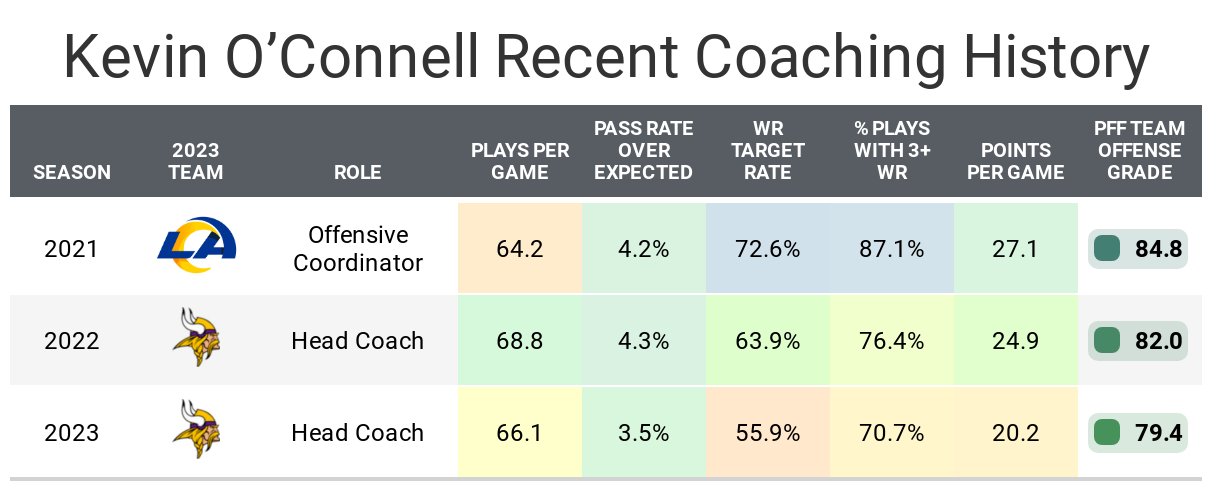
RB Jaleel McLaughlin, Denver Broncos (ADP: 13.04)
McLaughlin was the sixth-highest-graded running back last season with an 86.2 offensive grade. His yards per carry and avoided tackle rate were both top 10 among running backs. He also led all running backs in targets per route, leading to a top-10 yards per route run figure (1.63).
There wasn’t much consistency in how the Broncos used their running backs from one week to another. McLaughlin was sued significantly early in the season, phased out in late November and phased back in by mid-December. Samaje Perine played fewer snaps as the season progressed. There is talk of Javonte Williams having a better season one year further removed from his injuries, but Sean Payton has also praised McLaughlin’s work ethic this offseason. The Broncos also drafted Audric Estime in the fifth round to complicate matters.
McLaughlin didn’t receive any work with the starters in the Broncos’ first preseason game, but he played 11-of-20 snaps with the starters in the second game, including taking a third and long over Perine and taking snaps by the goal line. McLaughlin’s work ethic appears to be manifesting into a larger role with Denver.
Perine was released on cut-down day and landed with the Kansas City Chiefs. This makes McLaughlin the favorite for taking those third-down and two-minute drill snaps.
McLaughlin is on the shorter side for running backs at 5-foot-8, but Sean Payton is no stranger to shorter running backs. Payton’s former team, the New Orleans Saints, has the second-most offensive snaps for running backs 5-foot-9 or shorter over the last 15 seasons, including Mark Ingram II, Pierre Thomas and Darren Sproles. All three have multiple seasons where they’ve been fantasy starters.
It’s OK to take chances on Williams, McLaughlin and Estime because someone is bound to have fantasy value this season. Payton has a long history of producing successful fantasy running backs. It’s certainly possible McLaughlin carves out a big enough role in the offense to consider starting him in fantasy football.
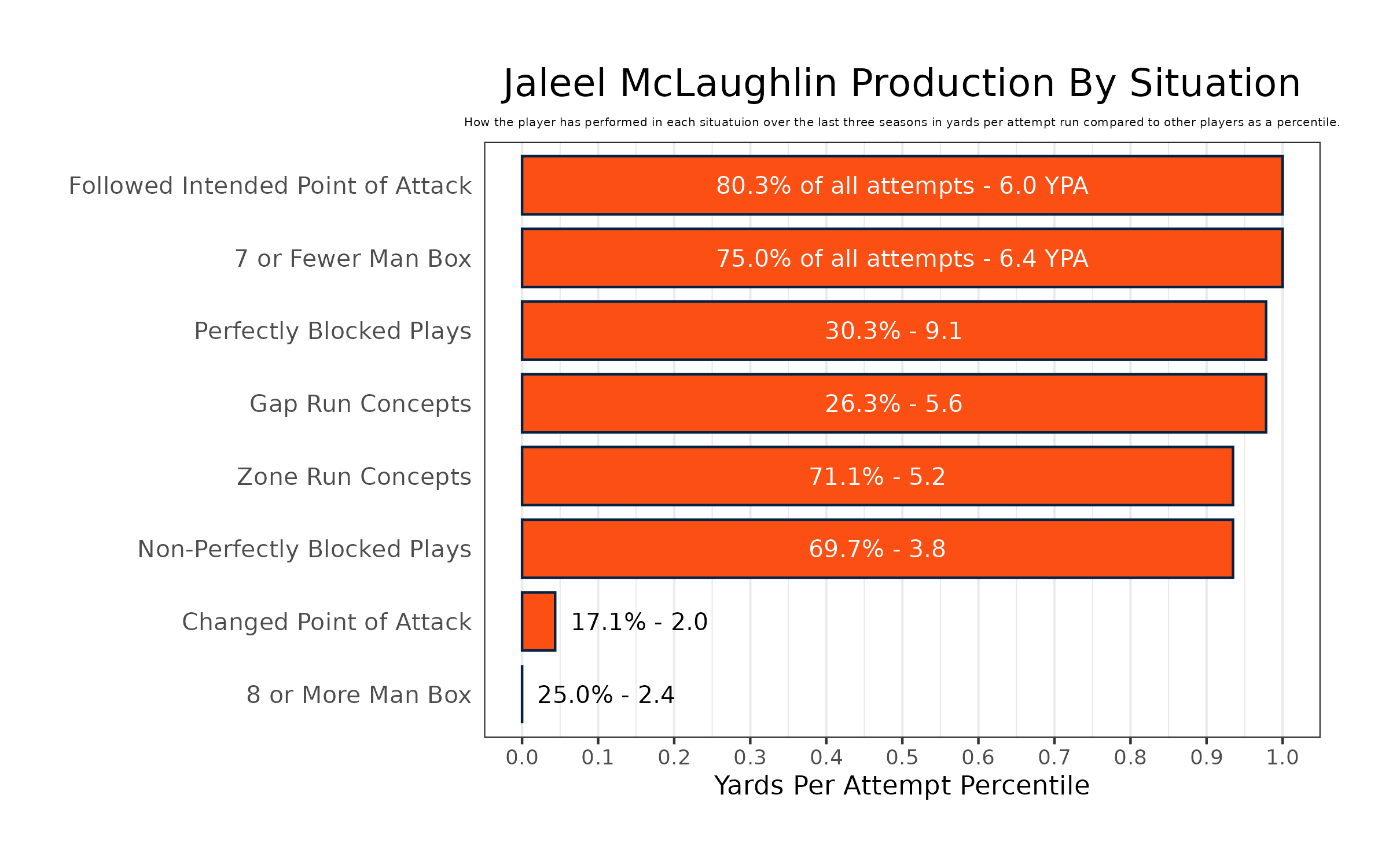
RB Bucky Irving, Tampa Bay Buccaneers (ADP: 15.07)
Irving was selected with the 125th overall pick and had one of the best landing spots for a rookie running back.
Ten running backs were selected in the first four rounds, but some of the landing spots were the Miami Dolphins, San Francisco 49ers, Arizona Cardinals, New York Jets and Los Angeles Rams. All five teams had running backs who ranked in the top 10 in PFF offensive grade last season. The Philadelphia Eagles and Green Bay Packers added big-name running backs in free agency who were at one point top-three running backs by PFF grade.
This leaves Jonathon Brooks to the Carolina Panthers, Ray Davis to the Buffalo Bills and Irving to the Buccaneers as the only running backs drafted with anywhere close to a good landing spot. Chuba Hubbard and James Cook were among the top 16 in rushing grade last season. This leaves Irving as the running back with the least competition for a potential starting job.
Rachaad White put up plenty of fantasy production last season, but his 68.8 rushing grade was the 11th-lowest among the 53 running backs with at least 300 snaps. Most of the bottom 10 are set for a decline in snaps this season, including two unsigned free agents. The Buccaneers' other backups, Chase Edmonds and Sean Tucker, didn’t play much better last season. This means Irving could have the second-best odds outside of Brooks to win his team’s starting job without any injuries among the rookie class.
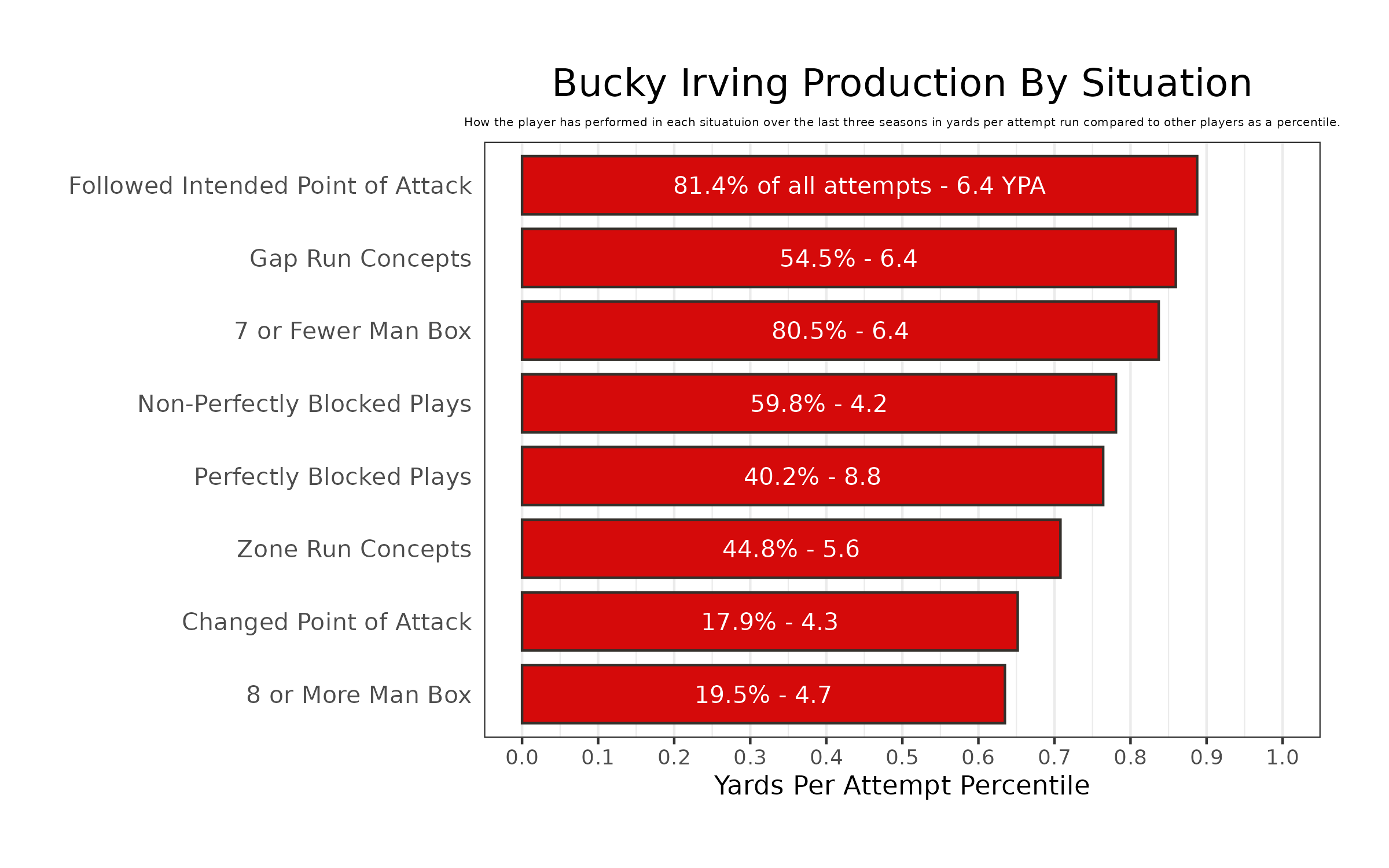
RB Tank Bigsby, Jacksonville Jaguars (ADP: 20.03)
Bigsby was the talk of training camp but a few major errors prevented him from becoming a major part of the offense. He dropped three of his five targets, all three of which flew up into the air after bouncing off his hands. Two of the three resulted in interceptions. He also picked up a fumble after Trevor Lawrence was hit while throwing the ball. He seemed to think it was an incomplete pass, allowing the defense to force a fumble resulting in a defensive touchdown. In the run game, he lost a fumble on one of his 51 attempts.
The one bright spot is he was an effective short-yardage runner when given the opportunity, converting nine of 11 first downs when he needed one or two yards compared to just a 58.3% rate from Travis Etienne Jr.
The good news is that the game is starting to slow down for him, which should help with the ball security issues. Etienne was a feature back for much of the first half of the season, but he was rotated out a lot more in the second half. They intend to reduce his workload again in 2024, which should give Bigsby plenty of opportunities.
It’s unlikely Bigsby will see enough playing time normally to warrant being a fantasy starter, but there is at least a chance if he more consistently takes short-yardage situations, particularly at the goal line. Bigsby is primarily on this list because he could be a feature running back if Etienne were to suffer an injury.
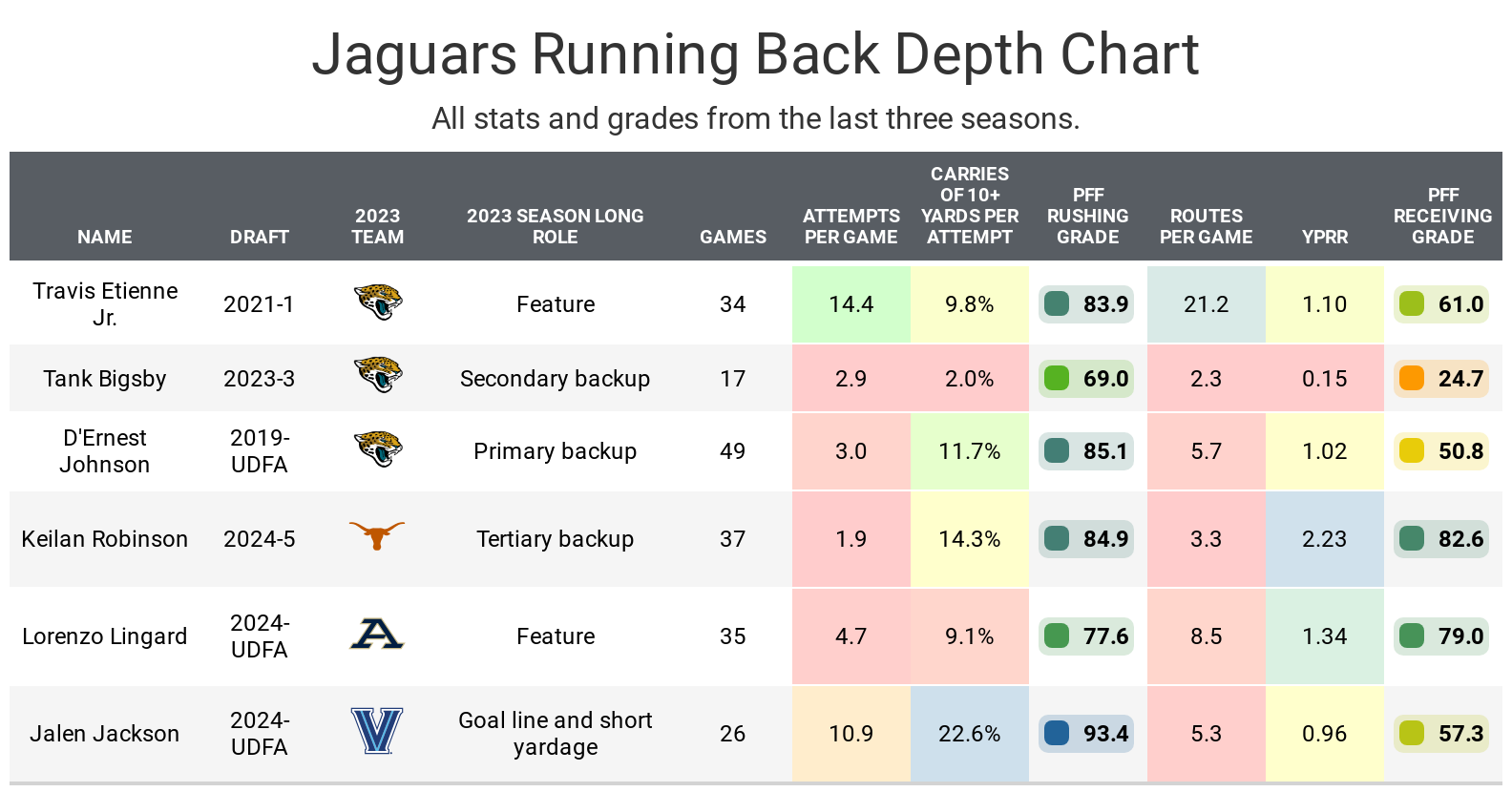
WR Brandin Cooks, Dallas Cowboys (ADP: 12.07)
Cooks was a top-20 fantasy wide receiver six times over a seven-season stretch from 2015 to 2021. He was often helped by his quarterback play from Drew Brees to Tom Brady to Jared Goff to Deshaun Watson. Even in 2021 with Davis Mills, he finished in the top 20, but in 2022, injuries took their toll and he wasn’t scoring touchdowns on the second-lowing scoring offense.
Last season, he joined the Cowboys, but it took time before he really clicked in the offense. He was inactive in Week 2 and helped to 50 receiving yards or less in every game over the first half of the season. He then broke out with a nine-catch, 173-yard performance. From that point on, he was consistently playing at least 70% of Dallas' offensive snaps. He was WR14 from Week 10 until the end of the season while his teammate CeeDee Lamb was WR1 by a wide margin.
Cooks has remained a wide receiver who is pretty good at everything outside of shorter routes, and the Cowboys will likely need Cooks more this season than last. Dallas allowed Tony Pollard and Michael Gallup to leave in free agency and didn’t bring in any notable pass catchers.
He is pretty unlikely to finish as a top-10 fantasy receiver given Lamb’s target share and some of his fantasy production came from touchdown luck, but there is a strong case for him to be a fantasy starter if he builds off what he did at the very end of last season. He caught at least five passes in each of his last three games including the playoffs after accomplishing that just once in the first 16 weeks.
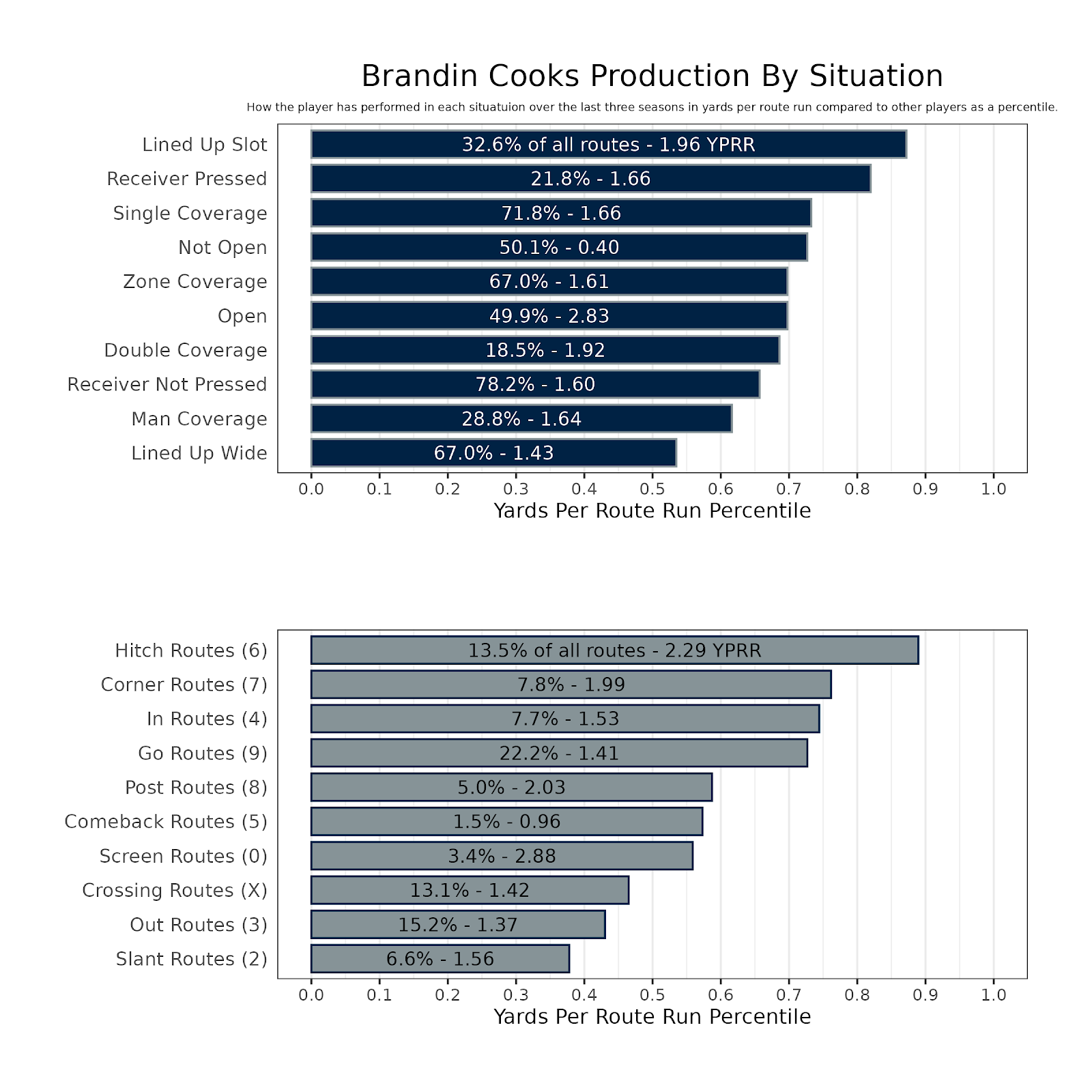
WR Ja'Lynn Polk, New England Patriots (ADP: 13.11)
Polk was the 10th wide receiver selected during the NFL draft, 11th on our big board heading into the draft, but 13th by consensus ADP, behind receivers like Roman Wilson and Jermaine Burton. Unlike Wilson and Burton along with multiple others ahead, Polk has a chance to be the top wide receiver on his team.
The Patriots had seven different receivers with at least 100 snaps last season and no one above 600. The only departure is DeVante Parker, who led the group in snaps last season while adding K.J. Osborn in free agency and Javon Baker in the fourth round.
During the preseason, Polk served as the primary backup at Z receiver behind K.J. Osborn and the primary backup in the slot to DeMario Douglas, which has included some snaps with the starters. Kendrick Bourne may complicate this, but he will miss at least the first four weeks of the season while on an injury list. There is still time for Polk to work his way up the depth chart and overtake Osborn as a starting receiver. By the final preseason game throughout the first half, Osborn and Polk were in a near-even rotation.
If he becomes a starter, he would be the Patriots' top outside wide receiver. Several rookie wide receivers are just learning the slot or just learning out wide, and the fact that Polk is learning both is a great sign of his immediate potential. He probably isn’t someone to start in Week 1, but by the mid-point of the season, it’s reasonable to expect him to be leading the team in targets.
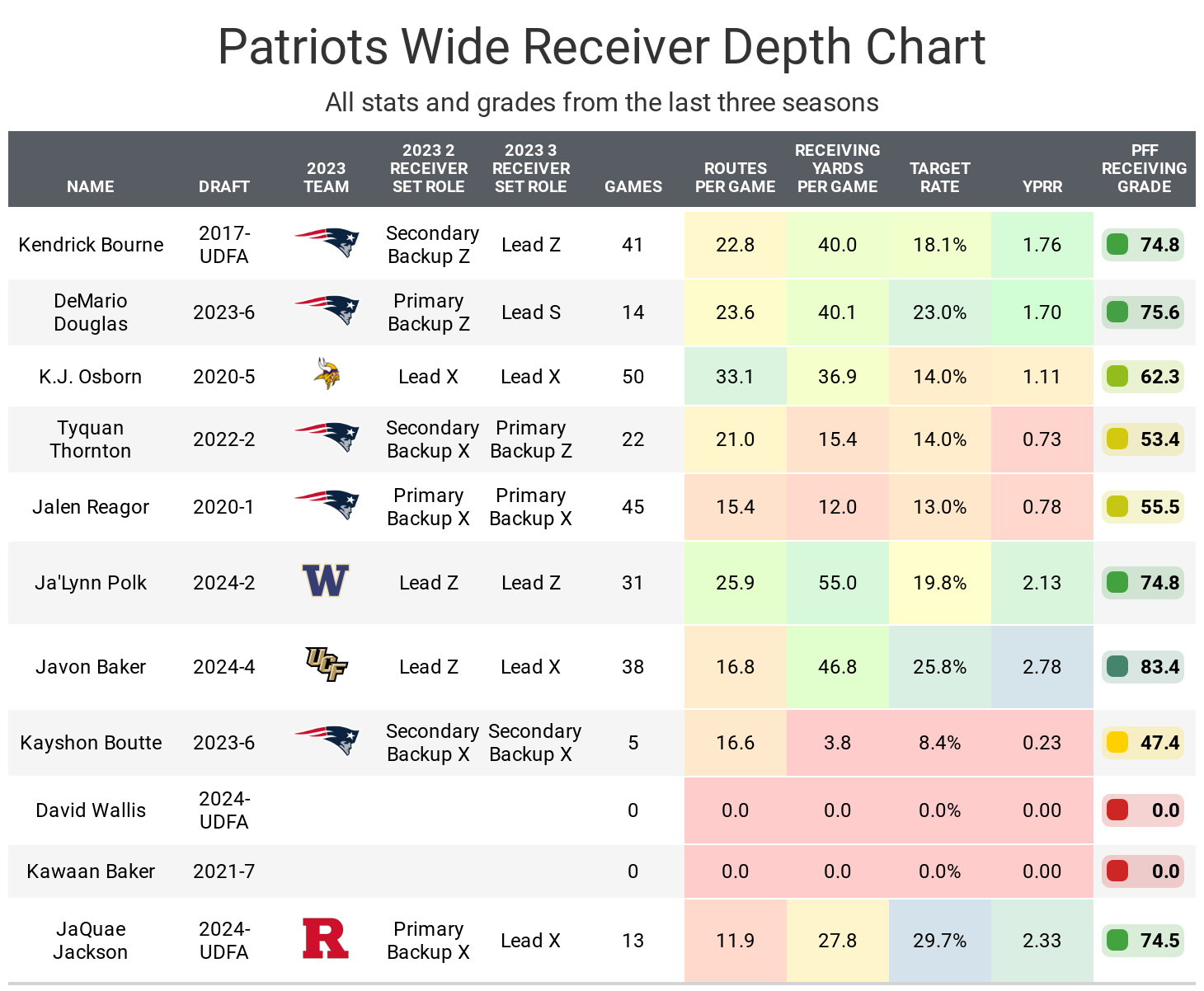
WR Michael Wilson, Arizona Cardinals (ADP: 17.12)
Wilson was a third-round pick by the Cardinals last season and was immediately put in as their Z receiver. He had a slow start in Week 1, leading to a reduction of playing time, but he rebounded in Week 2 leading to his playing time getting restored and was WR40 from Weeks 2-8. He accomplished this despite having Joshua Dobbs as his quarterback.
Wilson suffered a shoulder injury causing him to miss Week 9, and then he re-aggravated the injury in Week 11. He also suffered a neck injury. He returned for the last four weeks of the regular season and was held without a catch in his first two games back. Not only was he returning from injury, but this was also his first opportunity to play with Kyler Murray. Things with Murray clicked over the last two weeks of the season, and he was WR16 over Weeks 17-18.
The Cardinals replaced Hollywood Brown with Marvin Harrison Jr., traded away slot receiver Rondale Moore and added veteran Zay Jones, who can back up Harrison, Wilson and Greg Dortch in the slot. This means Wilson’s role in the Cardinals offense should remain similar to last season.
The exciting part about Wilson this season, outside of his health, is that he was more of a deeper threat. His 14.1-yard average depth of target was among the top-10 wide receivers last season who ran 400 routes. With Brown off the roster, he could see even more deep targets. Murray has the third-highest accuracy percentage among quarterbacks on deep passes over the last four seasons among those with 50 or more deep attempts. He’s also the most consistent on accurate-plus throws or throws where the pass is perfectly accurate or away from coverage.
Every indication is Marvin Harrison Jr. is the safest wide receiver picked in a long time, but there is a chance he doesn’t work out immediately or he suffers an injury. That chance alone makes Wilson an interesting option this late in the draft, but even if that doesn’t happen, Wilson should outperform his ADP.

TE Taysom Hill, New Orleans Saints (ADP: 17.06)
Hill has been one of the most intriguing players in fantasy football for years. In 2020, he started four games at quarterback when Drew Brees was injured and averaged 21.6 points per game, primarily due to his rushing production.
Leading up to those games, most fantasy websites listed him as a tight end, which sparked debates about whether he should retain tight end eligibility. Similarly, in 2021, Hill started at quarterback from Week 13 to 17, where he averaged 19.5 points per game.
Currently, Hill's positional eligibility varies across platforms: ESPN and Sleeper had him with duel eligibility at both quarterback and tight end from the start of the offseason. Yahoo! recently gave him duel eligibility after seeing his preseason usage. My Fantasy League lists him solely as a quarterback.
In 2022, Hill primarily saw action at quarterback, often in wildcat formations. However, in 2023, his role shifted more towards tight end. He lined up 80 times in a traditional tight end stance, 130 times in the slot, 71 times out wide, 115 at quarterback and 29 in the backfield. Hill also recorded a career-high 33 receptions last season.
The Saints still list Hill as a quarterback on their roster and depth chart, primarily due to the emergency third quarterback rule. Given his unique alignment distribution, there’s no definitive answer to what position he should be labeled as, since no other player has a role quite like his. ESPN's approach of granting him eligibility at multiple positions in fantasy football seems to be the most fitting, reflecting the various positions he plays in real life.
For the past seven seasons, Pete Carmichael has been Hill's offensive coordinator, with Sean Payton as his head coach for most of that time. It seemed unlikely that Klint Kubiak would use the soon-to-be 34-year-old in the same way as his previous coaches. However, through two preseason games, it appears that Hill might be used even more than before.
In the Saints' first preseason game, Hill was utilized more as a receiver, playing each of the first six snaps in various positions: two snaps out wide, one in the slot, two at tight end, and one in the backfield.
In the second preseason game, Hill started at halfback over Jamaal Williams, taking six snaps at tight end, four at halfback, four at fullback, and one in the slot. He played 14 of 22 snaps with the starters, ran the ball five times, and scored a touchdown. While it's important to note that the Saints were without Alvin Kamara and Juwan Johnson in this game, Hill's versatile performance remains impressive.
Hill, the team’s highest-graded rusher, averaged 5.0 yards per attempt in 2023, a full yard more than any of their top three running backs. He finished 2022 with the ninth-most fantasy points among tight ends and 2023 with the 12th-most.
Hill could rank even higher this year if his preseason usage carries into the regular season.

TE Colby Parkinson, Los Angeles Rams (ADP: 20.07)
Most NFL teams are sticking with the same top tight ends as in 2023, which could make the fantasy leaderboard look similar to last season's.
Most teams that have changed their lead receiving tight end are opting for experienced players. Examples include Zach Ertz with the Commanders, Mike Gesicki with the Cincinnati Bengals, Jonnu Smith with the Miami Dolphins, and Hayden Hurst and Will Dissly with the Los Angeles Chargers. All of these players have had some level of fantasy success before, and while there is a chance they can replicate it, only Ertz has a realistic shot at an elite season.
Parkinson is the biggest unknown among potential fantasy starters. The 25-year-old tight end spent the last four years with the Seattle Seahawks, gradually working his way from fourth on the depth chart to second last season. However, he was always part of a heavy rotation of tight ends in Seattle, leaving his potential as a primary fantasy contributor still uncertain.
Tyler Higbee has been the Los Angeles Rams‘ primary tight end for several years, but he struggled with multiple injuries in 2023 and will be 32 years old before the season ends. In a surprising move, the Rams signed Colby Parkinson to a two-year, $22.5 million contract with $15.5 million guaranteed, making him one of the highest-paid tight ends in the league—earning more than half of the NFL's starting tight ends, but so does Higbee.
While Parkinson has shown flashes of potential in specific situations, there's little evidence to suggest he's ready for fantasy stardom outside of his contract. Unlike other tight ends with clear talent and potential, Parkinson's value is more a product of his contract, with his actual talent level still largely unknown.
Given his new role, it might be wiser to draft Parkinson over players who have been around the league for years without consistently breaking into the top 12 fantasy tight ends. The fact that Parkinson has been the only Rams tight end to sit out throughout the preseason—while the team rested two running backs and four wide receivers—signals that he's the starter as long as Higbee is out. The key question now is whether he'll see enough targets to make a significant fantasy impact.
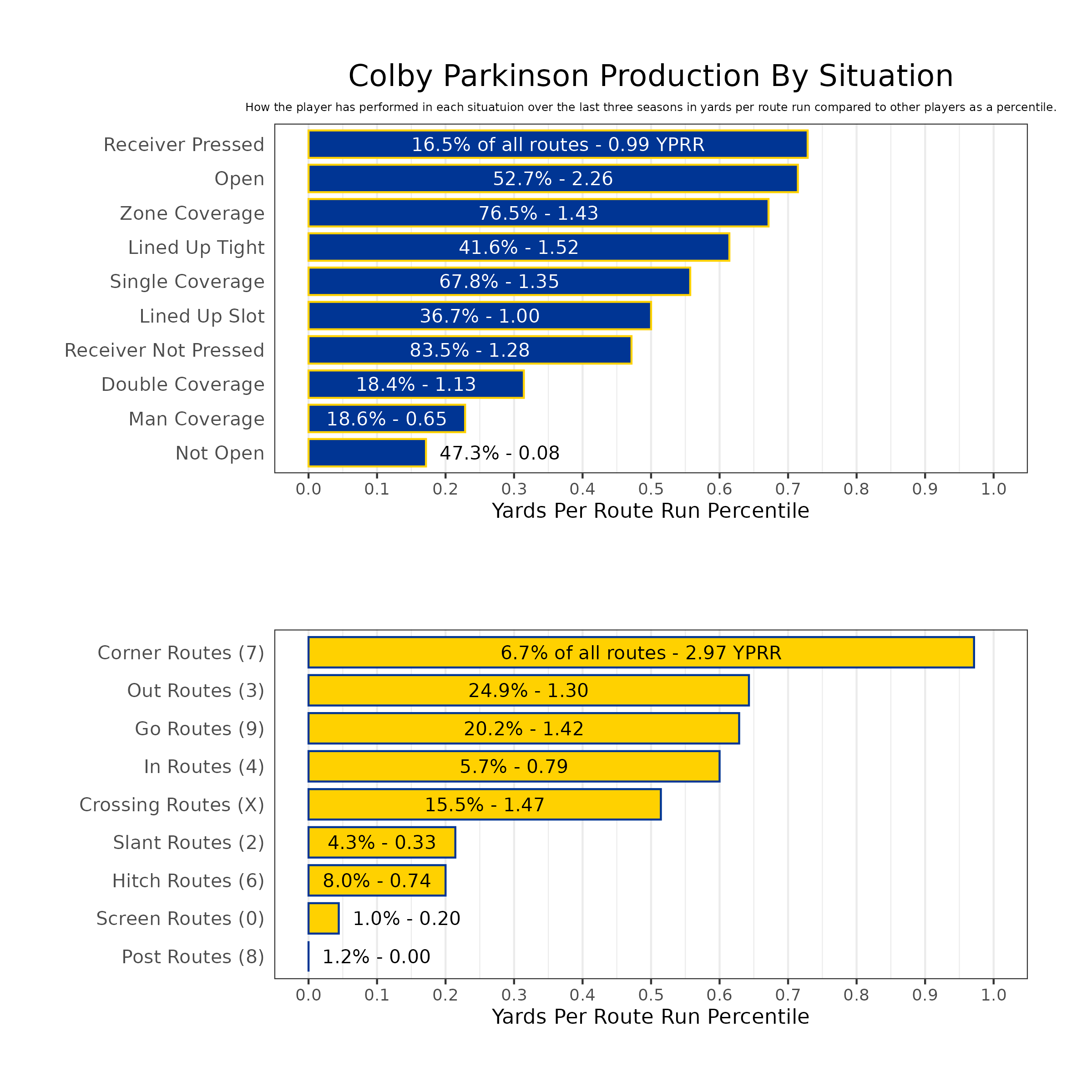


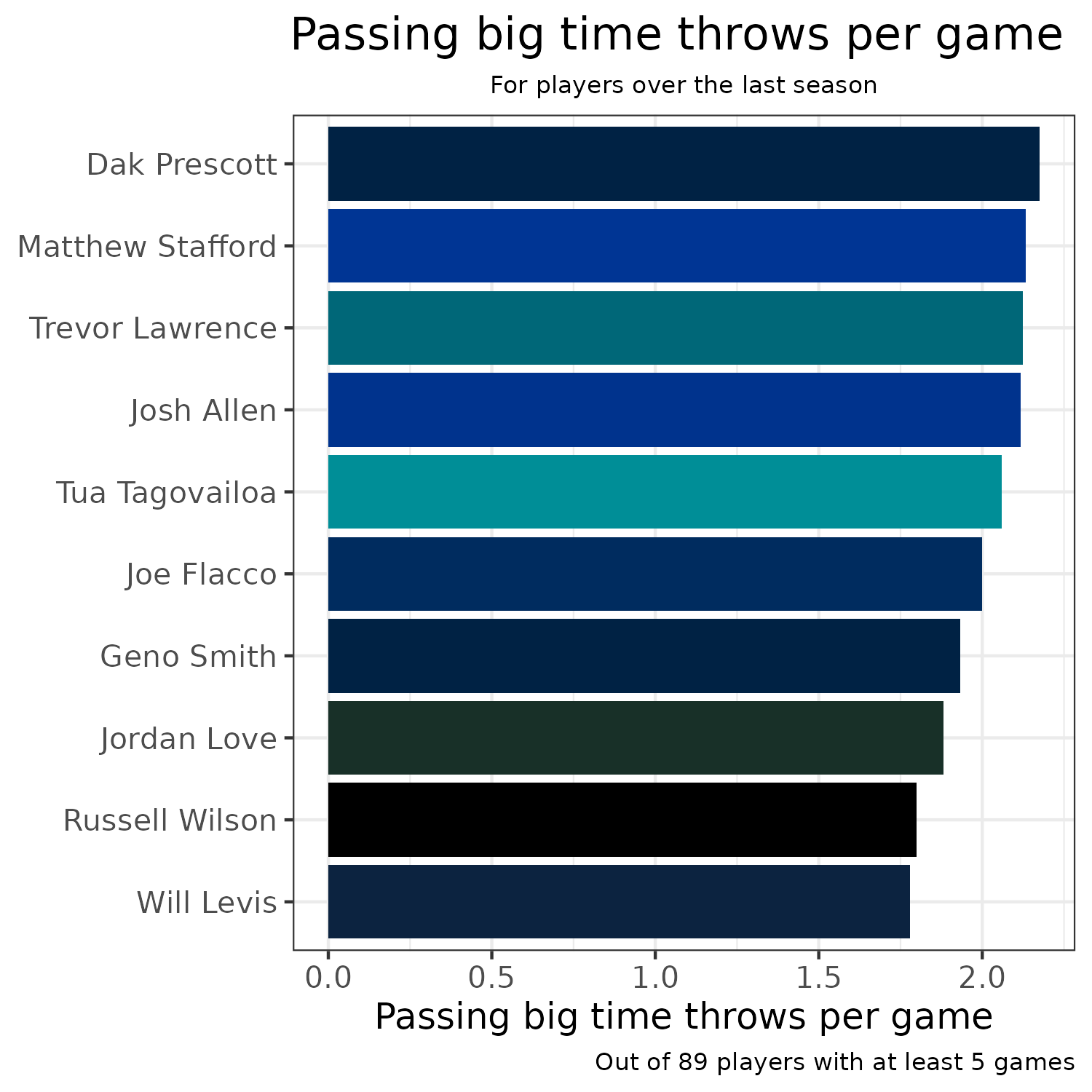


 © 2025 PFF - all rights reserved.
© 2025 PFF - all rights reserved.